| "Earth is the element of substance." |
| — Iroh to Zuko.[1] |
Earthbending, one of the four elemental bending arts, is the geokinetic ability to manipulate earth and rock in all their various forms. It is utilized by people of the Earth Kingdom and the United Republic.
Earth is the element of substance, making earthbenders and their people diverse, strong, persistent, and enduring.[1] The first earthbenders, Oma and Shu, learned this art from badgermoles.[2]
The key to earthbending is utilizing neutral jing, which involves waiting and listening for the right moment to strike and, when that moment comes, acting decisively. In other words, earthbenders generally endure their enemies' attacks until the right opportunity to counterattack reveals itself.[3]
Origin
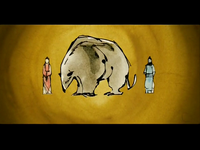
Oma and Shu, the first human earthbenders, learning from badgermoles.
During the era of Raava, the power of earthbending was temporarily bestowed on the inhabitants who lived on a giant lion turtle while they left the village to hunt for food. After the inhabitants permanently left the care of the lion turtle, humans first learned to reconnect and refine their earthbending by observing and imitating the geokinetic abilities of badgermoles that naturally inhabit the mountains in what is now known as Earth Kingdom territory. According to a legend, known widely as "The Legend of the Two Lovers", two star-crossed lovers named Oma and Shu, who hailed from separate warring villages, were the first people who learned the art from these creatures so that they could meet within the mountain that divided them. To make sure no one could ever find them, they used their new abilities to create a labyrinth of tunnels inside the mountain, which only they could navigate. One day, after many meetings in the series of passageways, the man did not come to see his lover, as he had died, a casualty of the villages' quarrel. His lover showcased a devastating display of her earthbending abilities and ultimately proclaimed the feud over. The villages subsequently collaborated to construct a city, Omashu, in their honor. The pathways they made by earthbending became known as the Cave of Two Lovers.[2]
'Earthbending' is written as 運土術 which in literal terms actually means 'move earth art' in Chinese.
Fighting style
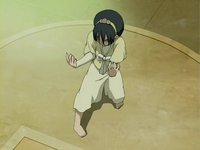
The Praying Mantis style.
Earthbending is one of the most diverse of the bending arts, ranging from the rigid and collectively learned earthbending of the Dai Li, which is the most commonly used earthbending style, to the individually taught styles, such as Toph's unique earthbending technique. Earthbenders are generally muscular, tough and direct, and like all benders their technique reflects on their individual personalities.
With the advent of pro-bending, earthbenders have learned to adapt fighting styles that are more suited to a fast-paced pro-bending match. Most earthbenders participating in pro-bending have learned to keep mobile and only root themselves long enough to actually launch and direct the earth discs provided in the arena. Bolin's earthbending is typical of the style used within the arena, although he has exhibited some of the more traditional forms and movements when outside of it.
Earthbending differs from the other bending arts in that it maintains a distinct balance between offensive and defensive capabilities (though waterbending involves a more refined version by channeling defense into offense). Earthbending uses a balance of strength and defense to overwhelm opponents.
The principle of jing is the essence of battle strategy of all bending arts, with a total of eighty-five possible actions. Positive jing occurs when one chooses to fight, while negative jing is when one chooses to evade. The earthbending discipline stresses neutral jing, which involves listening, waiting and attacking at the right moment.[3] King Bumi stressed this in his tactics against the Fire Nation; he allowed himself to be imprisoned in New Ozai for many months before liberating the city on the Day of Black Sun simply waiting for the right moment to fight and liberate the city.[4]
Earthbending abilities
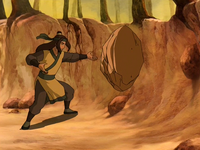
Haru earthbending.
Earth and stone levitation: The most common attack involves levitating nearby pieces of earth and stone of numerous sizes (more powerful benders can move larger masses) and propelling them at foes with punching or kicking motions.[5]
Earth block: Earthbenders can bring up blocks of earth and launch them at their enemies. The Dai Li used this technique against Team Avatar during the Day of Black Sun.[6]
Earth column: A more powerful version of rock projectiles, involving forcing columns of rock out of the ground. Using a similar principle, an earthbender can shoot a stream of small ruts and protrusions from underground at their opponent.[7] This can also be used to enhance the benders' jumps.[8] It is, however, limited to the ground and does not have the same range as a rock projectile.
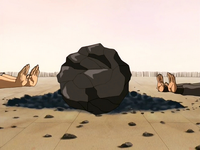
Earth compression: It is possible for earthbenders to compress large chunks of rock into smaller, denser chunks, or to compress several smaller chunks into one big piece of rock. Haru and his father, Tyro, used this technique, compressing several small pieces of coal into one big coal boulder. The fact that two earthbenders were required to perform it suggests that this technique is quite difficult.[9]
Earth gauntlet: A much less advanced version of earth armor that can be used to throw back opponents with hard solid force. Aang used this technique when fighting against Azula on the drill.[10] The technique is useful in that it grants some level of the protection of earth armor but allows the rest of the body to remain flexible.
Earth hand/mannequin: An earthbender with a decent grasp of sculpting can craft replicas of human appendages or bodies from any rock source and move them from place to place. While playing King of the Hill, Toph made a large hand to grab and toss Aang to the side.[11] When Toph was pretending to be Fire Lord Ozai as part of a training exercise, she used this technique to simulate the Fire Lord's bodyguards.[12]
Earth launch: While earthbenders like being rooted to the ground, with some like Toph being unable to see in the air, they can quickly move rock beneath them and launch them several tens of feet into the air, whether to catch airborne opponents or to travel faster. Toph and Bumi did this during the battle at Wulong Forest and the liberation of Ba Sing Se, respectively.[4][13]
Earth line: As an offensive attack, earthbenders can create a line of twisted columns and propel it forward.
Earth material manipulation: Earthbending is not limited to rock or soil alone. An earthbender can also manipulate coal, gems, crystals, and other earth-based materials, like meteorites and jennamite.[5]
Earth shelter: This can be used by earthbenders to create a shelter or dome which can provide an instant shelter in the wilderness. Toph often created shelters like these to sleep in while the Team Avatar was traveling[5] and used it to create a safe place where a pregnant woman could give birth.[14] It can also be used to trap enemies, but this application would not work against an earthbending opponent, who would be able to cancel out the technique.
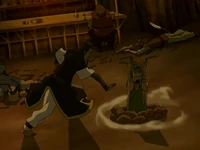
Yu sinking another person into the ground.
Earth sinking: More advanced earthbenders, such as The Boulder, Master Yu,[7] and General Fong,[15] can forcibly sink their opponents into the ground, imprisoning them or even suffocating them in earth. This technique was used by General Fong to subdue Katara.
Earth smash: Earthbenders can easily destroy rocks and boulders with punches and kicks, even if they have a small amount of muscle mass. This technique is useful when facing other earthbenders, as it allows the earthbender to destroy any earthen projectiles sent at them and break out of imprisoning techniques. However, it does not seem to affect objects not made of earth.[5]
Earth wall: Earthbenders can create walls of earth, which can be used for both defense and offense, as well as for practical things, like construction.[5]
Earthquakes/fissures: Striking the ground with feet, fists, or hammers, as shown by Gow, creates localized earthquakes or fissures to throw opponents off-balance.[16] This same process can be used to sculpt a landmass or to slice large chunks of rock clean off a surface to create avalanches or rockfalls. More advanced earthbenders can make narrow fissures for precise attacks.[5]
Quicksand: Earthbenders turn certain surfaces to quicksand to immobilize an enemy,[17] or to create a soft landing for themselves should they fall from a height. Sandbenders can also do the reverse of this, compacting sand together to create harder projectiles or a firmer grip on the ground.[18]
Rock hanging: If an earthbender is attached to, or wearing a piece of rock, he or she can attach to other stone surfaces and remain off the ground for long periods of time. The Dai Li are the only ones that have demonstrated this ability through the use of their earth gloves, giving them the ability to cling onto a rocky surface.[8]
Rock shield: A levitated slab of rock can also double as a shield when positioned in front of a bender. This can also be performed with a slab or sheet of bedrock thrust out of the earth's surface. The shield can be hurled at the opponent for quick retaliation.[5]
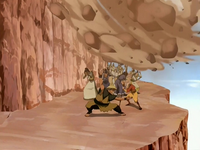
The canyon guide earthbending a rockslide.
Rock slide: If an earthbender is near a cliff or mountain, he or she can cause many rocks of a multitude of sizes to rain down on his or her opponent. The canyon guide demonstrated that it would be possible to redirect the path of a rock slide. This was shown when he protected his refugee customers from getting crushed.[19]
Sand spout: Similar to both the water and the air spout, an earthbender can manipulate the fine sand particulates to form a whirling column. The sandbenders used this technique to propel their sand-sailers through the Si Wong Desert.[20]
Slab shackles: With proper timing, an earthbender can bind an opponent's arms with triangle shaped slabs. This technique is generally used if the opponent is in a vulnerable position, for example on their knees. This technique was first used by Aang against Ozai to keep him in place while Aang took his bending away. It was later used by Aang to detain Yakone while he removed his bending.[21]
Water filtering: When working in concert with a waterbender, an earthbender can purify polluted water. The waterbender suspends the polluted water in the air, while the earthbender removes the pollutants and sets them aside.[22]
Earthbending master level
Dust cloud: By shaking the ground back and forth, earthbenders can create dust clouds of various size to provide cover,[7][10] and even manipulate the dust particles as shown by Toph.
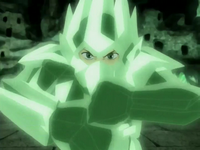
Aang in crystal armor.
Earth armor: Earthbenders can bring rocks, dust, pebbles, or crystals around them and mold them to fit their body and create something similar to armor. They can also hide inside the earth by bending the rock around them as a shell. Later, it is demonstrated by Toph that metal can be used as armor as well.[13] The earth armor was used by Toph in a training exercise with Aang.[1] Aang later uses this technique with crystals against Azula,[23] and again with rocks against Combustion Man[24] and finally Ozai.[13] This earthbending move is great for defense, especially against fire. It is not as effective for offensive moves, since it limits the practitioner's range of motion.[25]
Earth bomb: By sending a rock toward the ground, earthbenders can cause massive damage as well as throw their opponents off their feet. Aang used it against Zuko, almost gaining the upper hand of the battle before the Dai Li intervened.[23]
Earth tunneling: Earthbenders can move through the earth to out-maneuver their foes either by opening tunnels or by pulling the earth past them, literally swimming through the ground.[10][17]
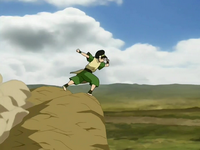
Earth wave.
Earth wave: High level earthbenders can create a wave of earth to ride on and use it as a form of transportation,[25] as Aang and Toph have both done,[23] as well as Roku and Sud while training.[26] The downsides of the wave are that it takes a lot of energy to produce, as well as intense concentration; the slightest distraction could cause the user to lose control of the wave. They can also force a wave of earth outward and use it as an extremely powerful offensive attack, as both Aang and General Fong were seen doing during their battle[15]
Magnetization: Skilled earthbenders are capable of magnetizing their limbs to any type of stone, making wall-scaling simpler in the appropriate circumstances.[27] The Dai Li agents could perform this move with ease and even stay upside down, such as when Team Avatar broke into the organization's secret headquarters in Lake Laogai.
Remote earthbending: If an earthbender is suspended from the ground, but is aware that there is earth somewhere near, the earthbender can focus his energies and bend that earth out of his physical reach out of sheer concentration. This was shown in a flashback when Bumi told Team Avatar, sans Aang, how he freed himself during the eclipse. Bumi managed to summon some roof tiles and pieces of walls to rip open the front of his metal coffin.[4] Aang also uses this technique to summon rocks for his Elemental Sphere while in the Avatar State.[28]
Avatar level earthbending
Compressed rock bullets: Used solely by Aang in his fight with Phoenix King Ozai. Aang disintegrated one of his compressed rocks from his Elemental Sphere and shot its shrapnel-like fragments with great speed, in a machine gun-like fashion. Due to the speed and density of these rocks, they did great damage to the landscape.[28] It is similar to the rock gloves technique used by the Dai Li.[23]
Greater earth levitation: With their greater power and stronger connection to the earth, the Avatar can move hill-sized statues at will. Utilizing the power of the Avatar State, Kyoshi moved large statues of badgermoles,[15] and Aang moved various earth pillars in his fight against Ozai, both for offense and defense.[28] Korra also used this technique in her fight with Zaheer, trying to crush her opponent with a hill-sized boulder.[29]
Powered compression: This is a much more powerful version of the earth compression technique, performed only by Aang while in the Avatar State. Instead of bending large chunks of earth into a single projectile, Aang gathered boulder-sized rocks and simultaneously compressed each fragment into smaller, denser, and harder rocks, essentially keeping the rocks under pressure for more volatile attacks if needed. Lastly, the rocks are directed to orbit the bender until they are used.[28]
Tectonics: The Avatar can earthbend on a scale vast enough to move entire landmasses, as shown by Avatar Kyoshi when she separated Kyoshi Island from the mainland.[30] Aang later performed the same technique to separate the town of Yu Dao from its surrounding land.
Special techniques
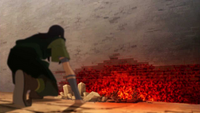
Ghazan bent the inner wall of Ba Sing Se to lava, bringing it down as a result.
Lavabending: Certain powerful earthbenders are able to change the phase of the earth they are manipulating, melting it into lava for more versatility in battle, similar to what waterbenders do with ice. A bender using this ability can form the lava into different weapons or summon magma from the ground.[31] Ghazan and Bolin are the only known non-Avatar earthbenders to have demonstrated this technique.
Metalbending: Metalbending is a sub-skill of earthbending developed by Toph. Most earthbenders are unable to affect processed metals. Usually, the trace amount of earth still present in metal is so minuscule that it goes undetected even by the best earthbenders, lending to its use in detaining earthbenders. However, due to her ability to "see" earth, Toph was able to locate the small fragments of earth in metal, target them, and utilize them to "bend" the metal portion. In the beginning, she was not able to bend metal with the same ability or ease seen in normal earthbending.[32] Eventually, her skill with metalbending developed to the point where she could effectively defeat comet-enhanced firebenders during the battle at Wulong Forest with the technique.[13] After the conclusion of the Hundred Year War, Toph founded a metalbending academy to teach the newly acquired skill to other earthbenders, and the technique eventually became the primary weapon of the Metalbending Police Force in Republic City. As metalbending techniques were further refined, benders eventually learned how to manipulate metal without being in close contact with it, and amateur metalbending students were able to apply this skill to small objects such as coins and canes.
Mudbending: It has been demonstrated that earthbenders are also able to bend the earth in mud. Toph, aided by Katara, was able to push the slurry from the rear of the Fire Nation drill back into the machine,[10] and the technique was also used by the two girls when they ended up fighting while they were training Aang.[33] Toph also used this ability while training Korra in the swamp.[34]
Rock gloves: The Dai Li have mastered the rock glove technique. Similar to an earth gauntlet, they cover their hands in small rocks and project them at a target as small projectiles or compacted fists to bludgeon an opponent.[8] A more refined and favored method however is to use them as detachable hands, maintaining the hand shape and literally grabbing and restraining the opponent from a distance.[35]
Rock shoes: The Dai Li also used shoes made out of earth to slide to travel faster and to cling to walls and suspend themselves on the ceiling, as Long Feng and the Dai Li used in Lake Laogai during their fight with Team Avatar and the reformed Freedom Fighters.
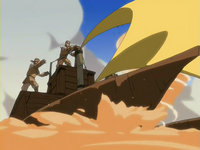
Sandbenders propelling their sand-sailers.
Sandbending: Sandbending is an alternate earthbending style that has been adapted for use in the Si Wong Desert by the people that live there. They move quickly in the desert on specialized wooden sailers that are propelled by bending miniature, localized sandstorms behind their sails. Because sand is sediment which travels in flows, their style resembles air and waterbending more than earthbending. It is implied that most, if not all, earthbenders are capable of easily bending sand, but because of the loose shifty nature of sand it is not an easy transition for the average earthbender. The sandbenders of the desert are especially proficient with it due to their particular habitat.[18] After the events at Si Wong Desert, Toph practiced her sandbending, achieving a mastery over it that allowed her to create an extremely detailed miniature sand version of Ba Sing Se.[12] Likewise, one can compact the sand to be solid and thick.[18] Sandbenders used this technique while stealing Appa.[36]
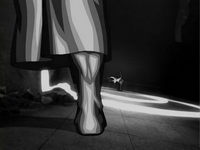
Toph "seeing" with earthbending.
Seismic sense: A technique originally developed by the blind badgermoles, skilled earthbenders are able to sense vibrations through the ground, "seeing" by sensing their surroundings and making a mental image of it. It allows for a 360 degree field of "vision", outside of normal line-of-sight.[7] To operate, the user needs direct contact with the ground, preferably without something like shoes in between.[37] The technique is only usable on surfaces the user can bend.[14] Being blind, Toph constantly used this technique to navigate the world; she described it as "kind of like seeing with [her] feet".[7] During his training with Toph, Aang also developed this ability. Aang used this during a three-way training spar with Toph and Katara,[33] and again during his fight against Ozai.[28] Due to Toph's extensive use of the technique, she discovered other applications of it. Her seismic sense was so acute that she was capable of sensing even ants moving about,[7] could identify people by the way they walked,[38] and could almost always tell if someone was lying by sensing his or her physical reactions, such as breathing and heart rate.[6][8] It was also the basis of her unique ability of metalbending.[32] Toph also passed this technique to her daughter, Lin.[39]
Opposing bending art
Earthbending is the opposing bending art to airbending. When first learning to earthbend, the pupil must first learn confrontational tactics and familiarity with the brute strength necessary to work with earth. This contrasts with the emphasis of airbenders on mobility and evasion. Earthbenders require a firm root in the ground, while airbenders are constantly moving. This is illustrated when Aang initially had great difficulty trying to learn earthbending from Toph.[1]
Like all of the bending arts, earthbending is balanced so as not to be more or less powerful than the other arts. It is the skill and prowess of the user that determines victory.
Weapons
Earthbenders have been known to use hammers and fans to augment their bending, and it has been stated that the Chinese great sword dadao, a heavy war sword, or literally "big knife", would also be best-suited for a strong earthbender. Aang has also demonstrated earthbending by wielding his glider-staff. Additionally, Gow has demonstrated earthbending with his war hammers,[16] and Kori Morishita was able control her meteor hammer with earthbending. Giant maces and axes could work well. Avatar Kyoshi was well known for using her twin fans to assist her in her bending forms, but particularly in earthbending.[30]
Weaknesses
Metal and wood: An extension of the last weakness, because almost all earthbenders do not know how to bend processed metals, the bending abilities of an earthbender can be negated by securing them within a metallic barrier, separating them from any contact with the earth. Toph, as the inventor of metalbending, is an exception to this, as are any who have been trained in the skill. However, even metalbenders cannot bend highly purified metals such as platinum. Wood cannot be subject to earthbending.[33]
Reliance on the lower body: Earthbending is at its strongest when the feet are in direct contact with the ground, enabling earthbenders to transfer their kinetic energies into their bending for fast and powerful moves.[40] However, this weakness can be overcome by bringing other body parts in contact with the earth.
Elemental symbol

The earthbending symbol.
The symbol for earth and earthbending is a tall rough isosceles trapezoidal shape, the base of which is made up of the Bagua trigram "Kun", denoting "earth". Inside, at the top, is a spiral running counterclockwise. The symbol is present on wooden "elemental solitaire" cards owned by Iroh.[41] This symbol vaguely resembles a seated badgermole.
Spirituality and earthbending
Earthbending was explored in depth while Toph was teaching Aang, and Iroh was teaching Zuko about the elements.[1] Earthbending expresses the aspect of neutral jing, which involves listening and waiting.[3] Earthbending also requires decisiveness; when the time comes to strike, it must be done without hesitation or uncertainty. If an earthbender lacks determination, the earth will not respond to their will. Being connected to the earth is also an important aspect of earthbenders' spirituality; earthbenders, mostly earthbending soldiers and generals, typically travel barefoot to increase their connection with the earth and their power.
Connection
The Hung Gar style of kung fu is the main influence for earthbending; they both feature "heavily rooted stances and strong kicks and punches that evoke the mass and power of earth." Hung Gar itself parallels animal movements such as the tiger's hard blows and the crane's affinity to landing gracefully on the Earth.[42] There are exceptions to this rule — Toph, the blind earthbender's style, is based on Southern Praying Mantis, a precise stepping skill which Toph uses to maintain constant contact with the ground and "see".
The concept of neutral jing is also closely related to the philosophy of "sticky hands", a practice common to some southern Chinese martial arts such as Chu Gar Southern Praying Mantis and Wing Chun. The purpose of sticky hands is to enable the practitioner to predict their opponent's next move. Similar to Toph detecting the movements of others through her connection with earth, a practitioner learns to detect their opponent's upcoming move by maintaining constant contact between their own arm and their foe's arm (may also be between their hands or wrists). By practicing with a partner in this manner, a practitioner will learn to "read" the slight movements of their opponent's arms to detect their next attack and subsequently move accordingly to either strike before the attack is made or move in the same direction with the attack and effectively neutralize it. Concepts such as listening, reacting, balancing attacks and defense, and drawing power from a stable lower body are often referred to in the practice of sticky hands, again, closely relating to many primary concepts in earthbending.
Notable earthbenders
- † indicates deceased during the series.
- L indicates known ability to use lavabending.
- M indicates known ability to use metalbending.
- S indicates known ability to use seismic sense.
|
The Legend of Korra
|
Trivia
- More earthbenders are born in the season of spring than in any other season.[43]
References
See also
External links
- The Hung Gar martial art, on which earthbending is based.
- Southern Praying Mantis, a specialized martial art style and alternate earthbending reference.